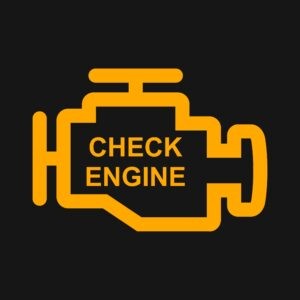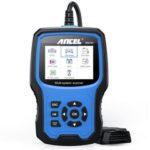As a Dodge Dart owner, seeing that check engine light illuminate on your dashboard can be concerning. While an OBD2 scanner is the quickest way to diagnose the issue, not everyone has one readily available. The good news is there are methods you can use to potentially retrieve these codes without a dedicated scanner, specifically on your Dodge Dart. Let’s explore how you can check OBD codes on your Dodge Dart without a scanner and understand what those codes might mean.
Using the Key Cycle Method on Your Dodge Dart
One of the most commonly cited methods for accessing diagnostic codes without a scanner involves using your vehicle’s ignition key. This method leverages the Dart’s onboard computer to display codes directly through the instrument cluster. Here’s how to attempt this on your Dodge Dart:
- Turn the Ignition to ‘ON’ (Without Starting the Engine): Insert your key into the ignition and turn it to the ‘ON’ position. This is the position just before you would crank the engine to start. Ensure all dashboard warning lights illuminate.
- Cycle the Key ‘ON’ and ‘OFF’: Turn the ignition key from the ‘ON’ position to the ‘OFF’ position and back to ‘ON’ again, repeating this cycle three times in quick succession. Leave the key in the ‘ON’ position on the third cycle. It’s crucial to not start the engine during this process.
- Observe the Instrument Cluster: After the key cycling, watch your Dodge Dart’s instrument cluster, specifically the odometer or information display area. If your Dart supports this feature, it may display a sequence of codes. These codes are typically four or five characters long and may start with a letter (like P, B, C, or U) followed by numbers.
- Record Any Displayed Codes: Carefully write down any codes that appear on the display. It’s important to note the exact sequence of characters for accurate diagnosis later.
It’s important to note that the key cycle method’s availability can vary depending on the specific year and trim of your Dodge Dart. If this method doesn’t yield any codes, it doesn’t necessarily mean there are no stored codes, just that your Dart might not support this particular retrieval method.
The Odometer Reset Method (Potential Compatibility)
Another method, sometimes mentioned for accessing codes without a scanner, involves using the odometer reset button. Compatibility with the Dodge Dart for this method is less certain, but it is worth trying:
- Locate the Odometer Reset Button: Find the odometer reset button on your Dodge Dart’s instrument panel.
- Press and Hold the Reset Button: Press and hold the odometer reset button.
- Turn the Ignition to ‘ON’: While holding the reset button, turn the ignition key to the ‘ON’ position (without starting the engine).
- Release the Reset Button: Release the odometer reset button while keeping the ignition in the ‘ON’ position.
- Observe the Odometer Display: Keep an eye on the odometer display for any diagnostic codes or messages that might appear.
Again, the success of this method can vary. If your Dodge Dart does not display codes using this procedure, you may need to explore other options.
Consulting Your Dodge Dart Owner’s Manual
A valuable resource for Dodge Dart owners is the vehicle’s owner’s manual. This manual may contain information about on-board diagnostic code retrieval methods specific to your model year. Check the index or the section on the instrument cluster or warning lights for any procedures related to accessing diagnostic codes without a scanner.
Taking Your Dodge Dart to a Professional for a Scan
While these methods might help you retrieve codes on your Dodge Dart without a scanner, the most reliable and recommended approach is to have a professional mechanic or a reputable auto parts store perform an OBD2 scan.
Many auto parts stores, like AutoZone, offer free OBD2 diagnostic scans. They can quickly connect a scanner to your Dodge Dart’s OBD2 port (typically located under the dashboard on the driver’s side) and provide you with the exact trouble codes and often a brief description of what they mean.
Taking your Dart to a certified mechanic or dealership is also a great option. They have advanced diagnostic tools and expertise to not only read the codes but also accurately diagnose the underlying problem and recommend the necessary repairs.
Understanding Your Dodge Dart’s Check Engine Light
The check engine light, also known as the malfunction indicator lamp (MIL), is a signal from your Dodge Dart’s engine computer (PCM or ECM) that it has detected an issue. The light can indicate a wide range of problems, from minor to severe.
- Solid Yellow/Orange Light: A steady yellow or orange check engine light usually indicates a less critical issue. It means the system has detected a problem that needs attention, but it’s generally safe to drive for a short period. However, it’s still advisable to get your Dodge Dart checked as soon as possible.
- Solid Red Light: A solid red check engine light suggests a more serious problem that requires prompt attention. While you may still be able to drive to a repair shop, it’s crucial to do so without delay.
- Flashing Check Engine Light: A flashing check engine light is a warning of a severe issue, often indicating an engine misfire that could damage the catalytic converter. This situation demands immediate attention. It’s generally not recommended to drive your Dodge Dart when the check engine light is flashing.
Common Reasons for a Check Engine Light in a Dodge Dart
Several factors can trigger the check engine light in your Dodge Dart. Some common culprits include:
- Emissions System Problems: Issues with components like the oxygen sensors, catalytic converter, evaporative emission (EVAP) system, or gas cap. A loose or faulty gas cap is a surprisingly common cause.
- Engine Misfires: Misfires occur when one or more cylinders in your engine are not firing correctly. This can be due to faulty spark plugs, ignition coils, or fuel delivery issues.
- Sensor Malfunctions: Various sensors monitor engine operation, including the mass airflow (MAF) sensor, throttle position sensor (TPS), and crankshaft/camshaft position sensors. Failures in these sensors can trigger the check engine light.
- Fuel System Issues: Problems like fuel leaks, low fuel pressure, or a clogged fuel filter can cause the light to come on.
- Exhaust System Leaks: Leaks in the exhaust system can affect emissions and trigger the check engine light.
- Transmission Problems: Although less common, certain transmission issues can also activate the check engine light.
Regular maintenance, including timely oil changes and addressing minor issues promptly, can help prevent some check engine light triggers.
Risks of Ignoring the Check Engine Light
Driving your Dodge Dart with the check engine light illuminated, especially if it’s flashing or red, carries several risks:
- Worsened Engine Performance: Engine problems indicated by the light can lead to reduced power, poor fuel economy, and rough running.
- Potential Engine Damage: Ignoring serious issues like misfires or overheating can result in significant and costly engine damage.
- Catalytic Converter Damage: A flashing check engine light often signals misfires that can quickly damage the catalytic converter, a costly emission control component.
- Increased Emissions: Many check engine light issues relate to emissions control, and ignoring them can lead to higher levels of pollutants being released into the environment.
- Safety System Impairment: In modern vehicles, engine and emission system data can be linked to safety systems like traction control and stability control. Ignoring engine warnings could potentially affect these systems.
- More Expensive Repairs Down the Line: Small problems can become major repairs if neglected. Addressing the check engine light promptly can save you money in the long run.
Resetting the Check Engine Light (Use with Caution)
It is possible to reset the check engine light on your Dodge Dart without a scanner, but it’s crucial to understand that resetting the light does not fix the underlying problem. It only clears the code and turns off the light. If the issue persists, the light will likely return. Resetting should only be considered after you have addressed the cause of the problem, or as a temporary measure to see if a minor, intermittent issue has resolved itself.
Method 1: Disconnecting the Battery
- Ensure Ignition is OFF: Turn off your Dodge Dart’s engine and remove the key from the ignition.
- Locate the Negative Battery Terminal: Open your Dart’s hood and find the battery. Identify the negative terminal, usually marked with a ‘-‘ sign and often a black cable.
- Disconnect the Negative Terminal: Using a wrench, loosen the nut on the negative battery terminal and carefully disconnect the cable.
- Wait 15-20 Minutes: Allow the vehicle to sit for 15-20 minutes. This allows the capacitors in the car’s computer to discharge, potentially resetting the system and clearing codes.
- Reconnect the Negative Terminal: Reattach the negative battery cable and tighten the nut securely.
- Start Your Dodge Dart: Start your car and see if the check engine light is off.
Method 2: Checking and Tightening the Gas Cap
Sometimes, a loose gas cap can trigger the EVAP system and turn on the check engine light. Ensure your gas cap is properly tightened. After tightening, it may take some driving cycles for the light to turn off if this was the only issue.
Important Note: Resetting the check engine light will also erase any stored diagnostic codes, which can make it harder for a mechanic to diagnose the problem if the light comes back on. It’s always best to have the codes read and the issue diagnosed properly.
Conclusion
While there are methods to attempt to check OBD codes on your Dodge Dart without a scanner, they may not always be reliable or provide the detailed information needed for accurate diagnosis. For the most effective and trustworthy results, utilizing an OBD2 scanner or seeking professional diagnostic services is highly recommended. Addressing the cause of a check engine light promptly is vital for the health, performance, and longevity of your Dodge Dart.


